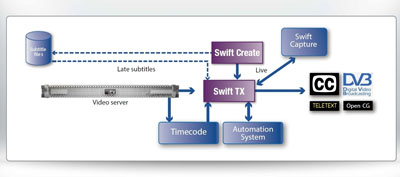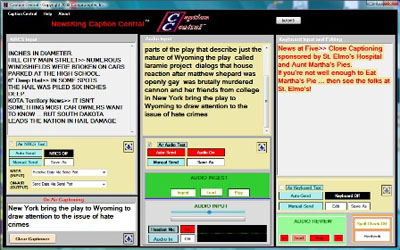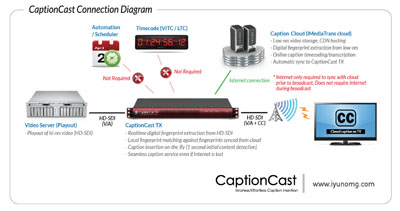Captioning Solutions at NAB Help Broadcasters Meet New Government Mandates
By most accounts, broadcasters and multichannel operators are making every effort to meet the FCC-mandated rules that call for all video content, whether on TV or the Internet, to include closed captions and/or subtitles by the end of this year or face a fine.
On February 20, 2014, the FCC set new rules for TV closed captioning to ensure that viewers who are deaf or hard of hearing have full access to programming. This followed a Report and Order on January 13, 2012 adopting rules for closed captioning of video programming delivered using Internet protocol (the "IP closed captioning rules"). These new closed captioning rules became effective on April 30, 2012. In addition, as of July 1, 2002, the FCC required all digital television (DTV) receivers to include closed captioning display capabilities.

Grass Valley's Swift TX transmission solution facilitates the playout and transmission of subtitles and closed captions in the full range of global formats and standards. All of these rules are part of the 1996 Americans With Disability Act, for which Congress required video programming distributors (cable operators, broadcasters, satellite distributors and other multi-channel video programming distributors) to close caption their television programs. In 1997, the FCC set a transition schedule requiring distributors to provide an increasing amount of captioned programming, as summarized above.
The Commission also adopted measures to ensure that people who are deaf or hard of hearing have greater access to local news programming. This includes making broadcasters convert teleprompter scripts into captions. This pre-scripting requirement has resulted in captioning for some news programming that previously aired uncaptioned, including sports, weather, and most late-breaking stories. In addition, the new rules require that crawls and other visual information be used to provide visual access to certain news segments that can't be pre-scripted.
The new FCC rules apply to all television programming with captions, and include standards for accuracy, synchronicity (timing), program completeness, and the physical placement of closed captions.
With this in mind, at this year's NAB Show several companies will show new and innovative ways to create or add captions to archived and new file-based programming.
In booth N605 (the Digital Broadcast booth) Comprompter will show its voice-activated Caption Central platform, which, the company says, includes "at least six methods of manually ingesting voice captioning, newsroom computer systems, as well as keyboard and text files. We must take what we get from the NRCS in terms of spelling; the same for pre-saved audio and text files. We must depend on the typist's level of accuracy."

Comprompter's Caption Central includes voice recognition capability that is "70-85% accurate for an untrained voice (depending on accents and clarity) and 95% for a person trained in captioning and transcription. But for general purposes, "Caption Central is just as accurate as your news staff is using your NRCS to provide caption output," says the company website. "The same goes for a live typist or pre-stored text files--unless there is time to edit them prior to air."
Comprompter said its Caption Central includes voice recognition capability that is "70-85% accurate for an untrained voice [depending on accents and clarity] and 95% for a person trained in captioning and transcription." It includes the ability to learn voices, but it can never be 100% accurate, according to the company. (Unofficially, the FCC Disability Rights Office is looking for about a 90%+ standard for Closed Captioning.)
Each individual person's voice does not have to be "trained" to use Caption Central as the system includes a "Mixed Profile" so that you do not have to switch Profiles when you switch speakers. In fact, Comprompter is nearly ready to identify speaker names as they come into each of the software's four channels.
Caption Central also includes a built-in Spell Checker, but the company also recommends using Microsoft Word on the Closed Captioning computer so that users have access to the Word Dictionary and its hundreds of thousand of words. It also features a Customizable Vocabulary that allows you to spell and pronounce proper names of people, places and things that apply to newsgathering. Once learned, Caption Central knows who and what these are.
So what happens if a station is using its newsroom system-generated captioning and the anchors suddenly go off script? Caption Central has an Ad-Lib Button that instantly switches the studio mics on and begins transcribing out to the Captioner what they are saying. As far as scripts go, the weather guy and half the sports show are typically ad-libbed, so this would be a great place for the Ad-Lib to kick in.
Users do not have to physically sit in front of the Caption Central computer during a newscast. Once set up, the computer runs fairly automatically. The AD-LIB button can be triggered Off and On remotely—from any designated computer screen.
Grass Valley, now owned by Belden, will show its Softel Swift Create V8 caption and subtitle creation workstation and its Swift TX transmission solution at NAB 2014 (Booth N2513).
Swift Create V8 is a major revision of the company's existing workstation. If now includes more than 20 new functions that simplify the processes required to create, repurpose and manage captions and subtitle files for multiplatform use.
With Swift Create V8's Direct2Web feature, captions and subtitles for content delivered to devices such as smartphones and tablets can match the quality of their traditional broadcast channel equivalents. The new software is also particularly adept at dealing with the minor captioning changes required to accompany video content delivered to a variety of platforms.
Swift Create V8's "Swift Smart File Handling Engine" supports a huge range of captioning and subtitling file formats and includes extended support for ingesting and captioning unconverted video. This "caption without conversion" capability means that users no longer have to create low-resolution proxy files to insert and process the required text.
Swift Create V8's "Smart Text" import tool saves review and editing time by using natural language processing to retain original sentence structures. Caption and subtitle repurposing for multiplatform devices is also accelerated through integral EDL file support, which automatically generates "reversioned" captions from edited video by only addressing areas where edits were made.
A user-definable "Profanity Guard" tool identifies and provides automatic substitutes for questionable terms, speeding through user-provided lists to ensure inappropriate words are either replaced or permanently deleted. And, in keeping with its name, Swift Create V8 includes a rapid review mode that fast forwards through video portions that do not have captions or subtitles assigned to them, significantly reducing the time required to review or QC the imported files. Automatic alignment checks performed by Swift Create V8 ensure that all captioning parameters will meet pre-defined criteria during the QC process.
The Swift TX transmission solution is a subtitle and closed caption processing platform that facilitates the playout and transmission of subtitles and closed captions in the full range of global formats and standards. It supports the transmission across DVB, Open, VBI and CC, as well as other ancillary data such as XDS.
Swift TX meets the demands of multi-language, multi-format time-of-air subtitle and closed caption transmission facilities; with automation play-list synchronization interfaces, and the ability to transcode between subtitle/caption standards in real time. In addition, Swift TX can act as a live format transcoder, converting from/to different subtitle and captioning formats. For example it has been used to convert from VBI-based teletext subtitles to DVB Bitmap subtitles. It will be shown at NAB 2014 being controlled by the company's iTX integrated playout solution.
In Booth #N6421, i-Yuno Media Group Americas, Inc. will show a variety of cloud-based captioning services, all designed to streamline various types captioning/subtitling workflows.
The company will demonstrate its subscription-based caption technology called CaptionCast; whereby customers install the CaptionCast server in their transmission facility and i-Yuno creates frame accurate captions on the cloud for automatic service at a mere $4/min. The customer uploads proxy video to the cloud and the rest is taken care of by i-Yuno. Once the operator's TV channel(s) air the specific content, the CaptionCast servers listen for the "audio fingerprints" from the SDI signal, pulls the matching captions and delivers them to the screen automatically.

"There really is nothing comparable on the market today that can identify audio fingerprints, pull captions from the cloud and insert them in the any part of the transmission chain, quickly and very accurately," said David Lee, CEO of i-Yuno Media Group Americas. "The cloud service and all of our captioning products have been very popular across Asia and we're now bringing it to North American broadcasters. So far, the reaction has been very positive among the major beta testers we are working with."
Used for near real time transcription or captioning for TV or any offline event, CaptionCrowd is an easy and fast caption service platform that allows captioners to simply type in what they hear. This, the company said, enables the production of high-quality captions at a portion of standard captioning prices. The unique system segments the video/audio into sentences and instantly distributes them to multiple captioners online. This cost-effective model allows the user to engage professional captioners that can work from anywhere—at home or on the move—saving time and money.
Subtitle/Caption Recut is i-Yuno's subtitling and captioning technology that combines with digital fingerprints for the world's first Automatic Recut. Original video files, matching subtitles/captions and edited video are uploaded to the cloud and the recut starts. It takes approximately 5-10 minutes for the digital fingerprints of an hour-long video to scan, verify differences and re-adjust the subtitle/captions. Various file formats can be downloaded for immediate use, or the iMediaTrans subtitle/caption editor can modify, verify, and export to a wide array of file formats.
The company will also show iMediaTrans Cloud, an advanced subtitling and captioning cloud service that offers hosting of proxy videos, CDN powered streaming to vendors or customers, timecoding and multi-language preparation of subtitles and captions using browsers. It also embeds many detailed features coming from i-Yuno's expertise as an international subtitling company. iMediaTrans Cloud also supports i-Yuno's SubtitleCast or CaptionCast platforms.
Telestream, which bought captioning veteran CPC last year, will show the latest versions of its MacCaption and CaptionMaker software in booth #SL3905. Since the acquisition of CPC, Telestream has continued to develop the products to ensure compliance with regulatory requirements while improving the user experience for content producers and distributors.
"Our captioning team offers a deep understanding of FCC and other mandates and continually applies that knowledge to our products to ensure that users comply with the latest and most stringent requirements," said Paul Turner, vice president of enterprise product management at Telestream. "Our intent is to give our customers the peace of mind of knowing that they are fully compliant, so they can focus on producing content for TV, web and mobile distribution, rather than keeping up with regulations."

Telestream has continued to improve its captioning software, for the Mac and Windows platforms. Telestream's closed captioning software products provide a full set of tools to help TV programmers and distributors address quality issues, in particular, fixing some of the more difficult synchronous and caption placement issues. Even when users choose to contract out the labor-intensive process of transcriptions, captioning software is essential for other steps of the workflow, the company said.
In addition to ensuring regulatory compliance, Telestream has developed new, improved versions of its MacCaption (Mac) and CaptionMaker (Windows) products that will be featured at the NAB Show. The user interface has undergone a more contemporary facelift, and new integrations allow Telestream's Vantage customers to automate many types of captioning-related workflows, including file-conversions. Telestream said it is continuing to leverage the synergies of its Vantage transcoding technology with its captioning technology and expertise.
Support for the latest caption formats and specs, including SMPTE 2052 and WebVTT with full CEA-608 compatible caption formatting, plus CEA-708 digital caption authoring will be included in the new versions.
Get the TV Tech Newsletter
The professional video industry's #1 source for news, trends and product and tech information. Sign up below.
